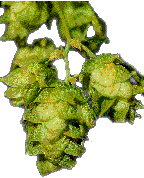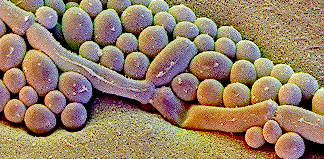Barley

Barley, a grain closely resembling wheat, is what turns water into beer. Barley is harvested, soaked until it starts to germinate, then is malted (roasted) to dry. The resulting grain is milled (cracked) and steeped in hot water to remove maltose. Maltose is a fermentable sugar, and is quite sweet. This sugar is turned into alcohol by the yeast. The types of barley selected is very important to the style of beer. Lightly roasted barley can be used in Pale Ales, where as dark roasted, even smoked malt can be used in stouts.
In an attempt to simplify brewing, some use malt extract. This comes in both powder and syrup form. The purpose is to create a concentrated form of maltose that can be transported more easily, and doesn’t require as much steeping. The extract is added to the water just before it boils. Malt extracts make brewing much easier for the home brewer, but don’t necessarily get the same quality as an all-grain brew. Some home brewers mix extract & grain, do all-grain, or even all extract beers. Many brewers tend to move towards all-grain because the quality of beer tends to be higher, and more complex.
Hops

Hops give beer the bitter flavor. You’re probably thinking “But I thought bitterness was bad?” Well, you’ve been duped by Coors & Co. Hops are an important and historical part of beer. They provide a bouquet of flavor, as well as offer the beer protection against microbial infection, and a number of other features. Recently, it has been found that hops, and their oils, are helpful in preventing breast cancer.
Here are a list of hop varieties, descriptions, and alpha acid levels. Alpha acids are considered the key factor in bittering. Hops are separated as bittering and aromatic. Bittering hops are boiled longer, and give the beer its bitter/hoppy taste. Aromatic hops are added late in the boil to give the beer its fresh hoppy aroma.
Determine how Bitter your beer will be with our IBU Calculator
Water

Water might seem unimportant. Its not. The type of water in a region usually dictated the style of beer that was brewed there. Two historic examples are Pilsner Urquell (Czech Republic) and Bass Ale (England). Pilsners are a lager beer that requires very soft water. Pilsners have a much cleaner body, and have much more subtle flavors. Pilsner Urquell is from Pilsen, where the water in the aquifers is very soft (fewer ions) than other places. This helped develop the style of beer, because pilsners are dependent upon softer water.
On each bottle of Bass Ale, you will find the name Burton on Trent, which means it was brewed in the city of Burton, on the Trent River. The water is much hard, so certain types of malt, and yeast are used to compliment the high ion count in the water. This is beyond most present day home brewer’s concerns, but there are volumes on water, and water treatment for home brewers. Tap water has been treated, but it can still contain microbes that will harm your beer. Be careful, and be clean when brewing.
Yeast

Yeast is everywhere. Wine is fermented from the yeast on the grapes, but beer requires special attention when fermenting. Yeast is the desired fermenting agent in beer. If something else is doing the fermenting, you might be in trouble.
The two major styles of beer are Ale and Lager. These two styles differ because of the yeast that is used to ferment them. Lager yeast ferments from the bottom, and at cooler temperatures (50 – 60F) and Ale yeast is top-fermenting, and tends to ferment at higher temperature (60-70F). The difference in yeasts can be tasted fairly easily. Think about the difference in taste between the previously mentioned Pilsner Urquell and Bass Ale. Pilsner Urquell has a very clean, delicate flavor, where as Bass has a very full, even fruity flavor. These are due in part to the yeast
As you learn more, you will learn which yeast to use with which style of beer, how to prepare the yeast, and maybe even how to cultivate your own cultures of yeast. Yeast is a fairly expensive part of brewing, and it must be handled correctly or you could end up contaminating your beer, and ruining a whole batch. Try getting your friends to drink beer that tastes like band-aides!